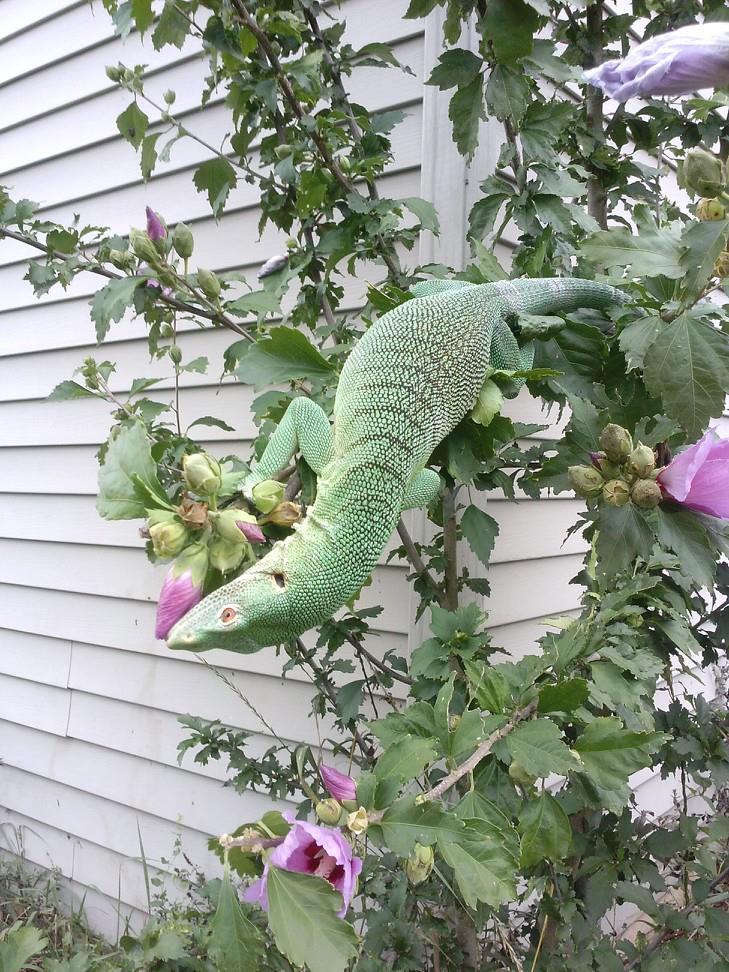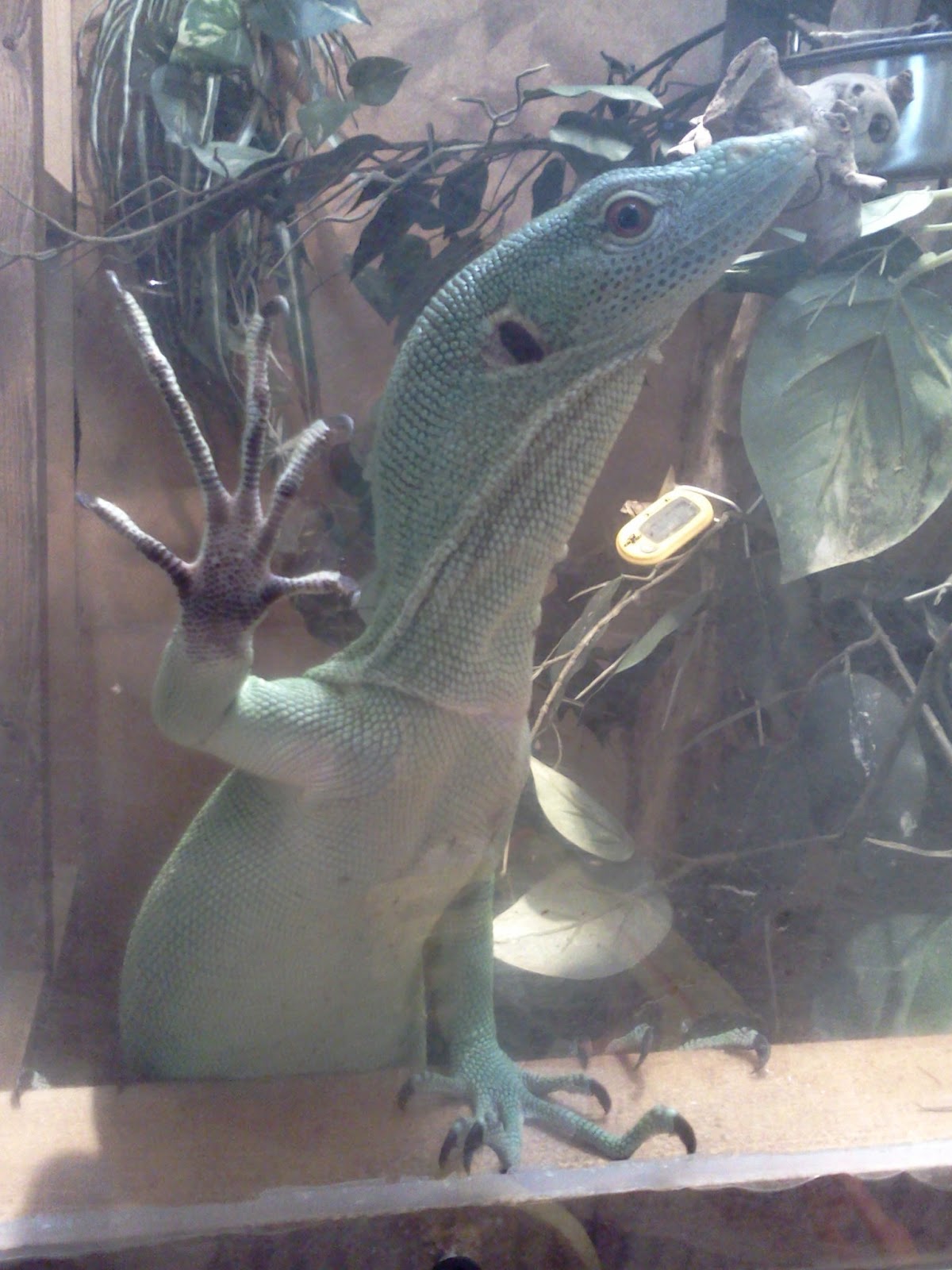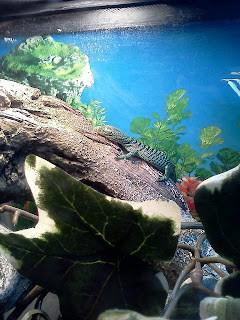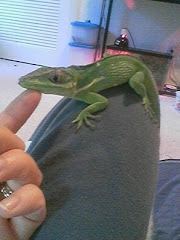Care for the
beautiful green tree monitor.
By Kathy Brown
 |
| Jade (female). |
The green or emerald tree monitor (Varanus prasinus) is bright green in
coloration with black cross bars down its back.
It can be seen with or without light blue flecks and has a light to dark
yellow throat and belly. As an arboreal
monitor, its long, linear body and limbs, along with its fully prehensile tail,
black rubbery foot pads and sharp needle like nails, make it well suited for a
life in the trees.
Varanus
prasinus is the smallest species in a group of monitor lizards known as the
prasinus complex. Adults typically reach
between 24 to 36 inches long, and about half this length is the span of their
tail. They are diurnal lizards, and
during the day, they can be seen climbing and jumping, sometimes swinging from
branches by their tails. Their alert,
curious personalities often outweigh their fear, and they end up investigating
everything new, including people.
 |
| Smelling the flowers. |
Arboreal Habitat
In the
wild, these monitors are found on mainland New Guinea and a few surrounding
islands. They inhabit rain and palm forests, mangrove swamps and cocoa
plantations. Keep these origins in mind
when housing them in captivity. Given
that they are a very active species, their minimum enclosure size is 6 feet
tall, 4 feet long and 2 feet wide. The
walls should be covered in something that allows these lizards to climb. I use cork sheets; not only are they a great
climbing surface, but they also help to maintain humidity.
When
building or buying an enclosure, it is important that it hold heat and humidity
well but still have good ventilation. In
my enclosure, I have a solid top and walls with ultraviolet and heat lights
attached to the ceiling inside. There
are two vents for air flow, one is at the top on the back wall and the other is
on the front wall at the bottom. This
placement allows for air circulation without losing too much heat and
humidity. Substrates that hold humidity
should be used; examples may include moss, cypress mulch, soil or a soil and
sand mix. Avoid rocks or pebbles, as
they do not hold humidity and could be accidentally ingested.
These
monitors need plenty of climbing branches, foliage, hides and a nest box. In my enclosure, I have a sturdy, central
tree. This was made by screwing smaller
branches onto a thicker, upright branch held in place by a plastic
Christmas-tree base. I then attached a
large cork tube and fake plants. There
are also artificial plants and vines attached to the enclosure’s walls. Hiding places and foliage are important for
making these monitors feel secure. Nest
boxes should be placed up high, toward the top of the enclosure, and filled
with damp moss. I use a nest box that is
around 3 feet tall, 1 foot wide and 2 feet long, with a branch attached under a
2 ½ inch hole. Monitors use these nest
boxes for sleeping in at night and for laying eggs.
 |
| Emeril and Jade's (V. prasinus pair) enclosure. |
Heat, Humidity and
Watering
Ambient enclosure
temperatures should be kept between 85 and 95 degrees Fahrenheit, with basking
areas between 110 and 120 degrees. Very young
green tree monitors prefer the lower side of 110 degrees for basking. If housing a pair of these monitors together,
provide two basking areas to avoid competition.
In my pair’s enclosure, I have one basking area at the lower side of
their temperature preference and one basking area at the higher side of their
temperature preference so they may thermoregulate accordingly. Heat is important for their digestion and
vitamin absorption. Also, if they get
too cold, it could lead to respiratory illness.
Humidity
is also imperative and should be kept between 70 and 100 percent. Failure to do so will result in dehydration,
as well as bad shedding, where toes and tail tips might fall off. Stuck sheds can cut off blood flow to these
areas, much like a tourniquet would.
Although I have never seen any of my nine tree monitors use their water
bowls, I still recommend providing one large enough for the monitors to soak
in. That said, if you see your monitor
soaking, this could be a sign of dehydration due to humidity being kept too
low. These are not aquatic/semi-aquatic
species, so excess soaking is a sign something is wrong. All the tree monitors that I keep prefer to
drink when I lightly mist them on the body and face. When they start drinking, I spray gently on
their mouth until they stop drinking. I
mist enclosures at least twice a day for this reason, and also to keep up
humidity. To further help with humidity,
I use a fogger, especially during the drier winter months.
 |
| Emeril (bottom) and Jade (top) basking together. |
Diet and lighting
In the wild, these monitors
primarily eat invertebrates. For this
reason, the main diet of my V. prasinus
is a variety of insects. In addition, a
couple times a month, I will offer meaty items such as rodents, chicks or
ground turkey mixed with a calcium/vitamin supplement and a small amount of
egg. These active monitors must be fed
daily. Adults typically eat about a
dozen insects a day. My green tree
monitor’s favorite commercially available insect is the lobster roach, and it
is the only type of roach they will eat.
They will also take crickets, locusts, hornworms, the moths the
hornworms turn into and occasionally superworms. Gut-load all insects with fresh fruits and
vegetables, dust them with a calcium with added vitamin D3 supplement once a
week and dust them with a multivitamin once a month. Vitamin D3 is important to reptiles, as it
allows them to absorb the calcium in their diet. Without it, reptiles develop hypercalcaemia,
a form of metabolic bone disease.
Also
necessary to prevent hypercalcaemia is the use of a UVA/UVB light. The UVB in these bulbs allows a reptile to
make its own vitamin D3. I recommend a
5.0 or 10.0 UV light for this species.
Care should be taken with the placement of these lights. Read the instructions that come with them to
find out how far away from the monitor they should be placed. Too close and the light could be harmful, too
far and the beneficial UVB will not be utilized. Replace UV lights every six months to a year,
as UV rays produced by these lights decay over time. The UVA, also put off by these lights, is
beneficial for overall reptile health and vision. Reptiles see UVA and without it, they are
essentially color blind.
 |
| Emeril (male). |
Quarantine and
Healthcare
Unfortunately, most V. prasinus in the pet trade are wild-caught. Not many people breed this species in
captivity for a variety of reasons. I
speculate that it is mostly because they require significant care and are
considered high-maintenance. The other
reason is probably because they are expensive to buy and keep. Hopefully, as their popularity increases,
more hobbyists will keep and breed this wonderful lizard.
Green
tree monitors are usually sold for $500 to $1,000 each, so it is important to
make sure they are healthy and stay that way.
Upon first receiving any new reptile, always quarantine it away from
existing collections for three to six months.
Wild-caught reptiles are often infected with parasites and/or
respiratory illness. Over half the tree
monitors in my collection were infected with both and needed treatment with the
proper medications. Reptiles can also,
more rarely, be infected with fungus, and if possible, should be kept in a
separate room away from other reptiles.
During
quarantine, new animals may be housed in large tanks. This aids in getting fecal samples for your
veterinarian, easy clean up of fecal matter and disinfecting when treating for
parasites, and easier access to the monitor when giving daily medications. It is important to note that when using tanks
with a screen lid, most of the lid must be covered to prevent heat and humidity
from escaping. I have had success using
foil for this purpose, but you can also use wood or plastic. After the first week, make an appointment
with a knowledgeable herp veterinarian for a health check and fecal exam. After your new V. prasinus is deemed healthy and parasite-free, you may move it
into a bigger enclosure, but do not expose this new lizard to any others before
the three to six month time period is up.
Some illnesses take a while to develop, and it is always better to be
safe than sorry.
 |
| Male side view of hemipenal bulges |
 |
Male underside view of hemipenal bulges. The dark patch under the tail base shown here are scale glands for scenting.
|
 |
| Female side view. |
 |
| Female underside view. |
Sexing and Reproduction
Sexing these monitors is
easy when you know what to look for.
Males have large hemipenal bulges at their tail base, which are visible
at an early age. Females also have bulges,
but they do not extend very far underneath or on the sides, as seen in
males. Both sexes can fully or partially
evert their sexual organs when frightened or defecating. This confuses most keepers, as they can look
similar. In females, you can see the end
of their hemiclitoris as a small, dark star-shaped tip, and eversion protrudes
this maybe a quarter to half an inch. In
males, that are only partially everted to the same length, the dark star-shaped
tip is not present. When males fully
evert their hemipenes, they are about 2 inches long.
Over
the years, a few zoos and hobbyists have been able to captive breed and hatch
out neonates of this species. In the
wild, it has been documented that in one instance, V. prasinus eggs were laid inside a termite nest, and upon hatching
the neonates consumed the termites before emerging outside the nest. In captivity, however, these monitors use
nest boxes filled with various types of moisture-retaining substrates. Females reach sexual maturity at two years of
age and have been observed laying clutches of two to six eggs up to three times
a year. Copulation occurs when a female
is healthy and well-fed enough to cycle.
The male and female will stay joined for hours, sometimes several days
before the copulation time-period is over.
Between 30 to 40 days after the first day of copulation, the female will
go in her nest box, dig a tunnel and lay her eggs. It is best to remove the male from the
enclosure a week before you think the female will lay her eggs. Females can be very protective of their nests
and have been known to kill males while guarding their eggs. After a week or more, you may reintroduce
males back into the enclosure.
I
remove eggs from their nest box promptly.
They are either placed into a Suspension Incubation Method container,
otherwise known as S.I.M. container, or placed in a container with moist
incubation substrate. Incubation
temperature is set to 85 degrees and neonates usually hatch within 150 to 190
days. Neonates usually take a few days
to hatch out of the egg completely.
After hatching, they are placed into a small ten gallon tank with a
partially-covered screen lid. The tank
is set up with climbing branches, vines, a hide and a water bowl. The preferred basking temperature of neonates
is around 100 degrees. They are small,
their skin very thin and it does not take long for them to heat up to desired
body temperatures. Care and feeding is
similar to adults, just on a smaller scale.
At one month of age you may move babies into a larger tank, 40-60
gallons and at six months of age you may move them into adult enclosures.
 |
| Breeding. |
 |
| Eggs in containers with incubation medium (top shelf) and eggs in a S.I.M. (bottom shelf). |
 |
| Hatching. |
 |
| Neonate. |
Temperament and
Handling
Varanus prasinus is a gentle-manned monitor that is typically all
bark and no bite when frightened.
Fleeing the scene is the first thing they try to do. If cornered, they inflate their throats,
slightly open their mouths and curl their tails to their bodies for
protection. Their tails are an invaluable
tool for climbing and are not used as a whip like some other lizards. They are also gentle when walking on people
and eating from someone’s hand. Mine
will actually turn their heads so they angle their bite on prey to avoid biting
my fingers.
Along
with being gentle, they are also smart and curious. Keep this in mind when building a cage. If there is possibly a way out, they will
find it. When I built mine, I used cord
grommets for the electrical cords. After
a year, my female decided to hook her claws into the tiny crack where the
grommet met the wood. She swung her whole
body out over and over until there was enough room to fit in her upper
jaw. She then jiggled and pried using
both her claws and her mouth, and eventually hung using her weight to
completely take it off. Luckily, I was
there watching and took her down off the top of the enclosure after she made
her exit. As a result, I now seal cord
grommets in place with sealant.
Due to
their curious personalities, and contrary to popular belief, these lizards can
become very tame and interactive with people.
The younger the lizard is when acquired, the easier it is to get it to
trust you. The best option would be to
find a very young, captive born V. prasinus. Unfortunately, these are hard to find. If possible, try to get young, wild-caught
lizards instead of adults. Adult
wild-caught V. prasinus are shy and
take some time to acclimate to captivity.
These adults can become tame after a while, but they are not nearly as
interactive with people as a baby raised by its keeper. With young V. prasinus, there is little to no effort in getting them to trust
you. Simply stick your hand in the
enclosure and wait for them to come over and check you out. Try not to move or make any noise as you do
not want to frighten them. Eventually,
curiosity outweighs fear, and they will slowly climb up to investigate. Be still and let them walk on you. Move slowly, and never grab them. After a few weeks of this behavior, the
lizard learns that you are not a threat and will want to come out and explore
more and more often. Handled daily in
short 10-to-15 minute sessions, a young V.
prasinus will become a very interactive adult monitor. Do not handle these monitors for more than 15
minutes at a time. Normal household
temperatures and humidity are not high enough for prolonged handling and too
much could cause illness.
 |
| Four month old baby. |
Inquisitive and
Engaging
The personalities of all
monitors in the prasinus complex appear similar. They are curious, inquisitive and interactive
with people once trust is established. I
frequently let all my tree monitors roam about my reptile room while I am in
there working. I only take out one
species at a time to avoid possible quarrels between them. All the monitors love to explore and walk
around. They like to watch everything
going on, what I am doing and if I happen to walk by, they just might leap on
my back!
The
pair of V. prasinus I have raised
from babies have no fear of people. They
readily jump from me to new people to investigate, often climbing in their
clothes to see what is in there. They
eat from my hand, sit on my head while I walk around and follow me indoors and
outside without ever running away.
Often, when my male is outside his enclosure, he rubs his scale glands
all over everything, including people, trying to mark his territory. He rubs his head, belly and the underside of
his tail base on objects and wiggles around.
This is very funny to watch! I’ve
kept many reptiles throughout my life, and I have to say V.prasinus is by far my favorite.
 |
| Emeril coming out of his enclosure. |
 |
| Emeril seeing what my daughter is doing on the computer. |
 |
| Baby investigating the window. |
 |
| Emeril getting a chin rub. |
 |
| Emeril trying to get to my son who is hiding under a shirt. |
 |
| Emeril wanting to come out. |
 |
| Emeril trying to get out to my daughter. |
 |
| Jade climbing my curtains. |
 |
| Jade crawling out of my friends pants. |
 |
| Jade investigating my plants. |
Others in the
prasinus complex
There are currently nine
known species of tree monitors belonging to the prasinus complex. These are green or emerald (Varanus prasinus), blue (V. macraei), yellow (V. reisingeri), kordo or biak (V. kordensis), black (V. beccarii), golden spotted (V. boehmei), V. bogerti, V. kehorneiith and V. telenestes. These
monitors are found in different locations, including New Guinea, its
surrounding islands and Australia. All
are arboreal and have the same body type, tails and specialized foot pads. Care for all of them is similar. Besides V.
prasinus, I currently keep V. macraei,
V. reisingeri, V. kordensis and V. beccarii.
 |
| Male blue tree monitor. |
Varanus macraei is found on Bantana and
is the largest species belonging to the prasinus complex. They can grow up to 38 inches total
length. Their main color is black to
dark blue, with bright blue ocelli and spotted bands across their bodies, limbs
and tail. Their snout, throat and belly
are light blue to gray, with or without orange flecks. Given that they are larger than V. prasinus, a larger enclosure would be
appreciated if you have the room. With
any of the tree monitor species, the bigger the enclosure, the better.
 |
| Female yellow tree monitor. |
Varanus reisingeri is found on Misol and
falls only an inch or so shorter in total length than V. macraei. The main color
of this monitor is bright yellow to neon green with black cross bars going down
the back, with or without yellow flecks.
Their throat and belly is light to dark yellow. The pair I keep are gorgeous and brightly
colored.
 |
| Female Kordo monitor eating a hornworm. |
Varanus kordensis is found on Biak and
is also only a few inches shorter than V.
macraei. This monitor is sometimes
mistaken for V. prasinus because its
main color is also green. Besides the
size difference in these monitors, they are different shades of green and have
different back patterns. This monitor’s
main color is olive green to grayish blue/green with a black lace or net-like
pattern going down the backs, which turns into black flecks when going down the
tails. Their throats and bellies are
greenish/gray to light brown. Although
not as brightly colored as V. prasinus,
V. macraei and V. reisingeri, they are still beautiful.
Varanus telenestes, called the Rossel
Island monitor, is found on Rossel and is protected. It has a black body and a cream belly
decorated with brown spots. Its throat
is banded. Total length is around 28
inches.
Varanus keithhornei, also known as the
canopy monitor, is the only tree monitor found in Australia and is
protected. It is located in the rain
forest region of Cape York in northern Queensland. It is dark gray to black with or without
faint large spots on the back and has a light gray colored belly. Its total length is around 30 inches.
Varanus boehmei is found on Waigeo and
is around the same size as V. macraei. It has a black body with golden yellow spots
and a light colored belly. It looks very
similar to V. macraei replacing the
blue markings for gold.
 |
| Female black tree monitor. |
Varanus beccarii is found on Aru and is
completely solid black. Its scales are
very shiny making it look like polished black onyx. Most V.
beccarii I have seen have brown eyes, but the one I have has bright
red/orange eyes. This makes for an
exceptional looking lizard. This monitor
reaches a total length of 37 inches.
Varanus bogerti, also known as Bogert’s
monitor, is found on Fergusson, Normanby and St. Aignan islands (off of
northeast New Guinea), and is protected.
It is dark, nearly black in color.
No live specimens have been found.
The preserved body discovered is currently at the Natural History Museum
in London. It is estimated to be around
29 to 39 inches total length.
Protected
All tree monitors in the prasinus
complex are listed as CITES II. This
means they are not endangered now, but trade needs to be regulated in a way as
to prevent over collecting. Different countries also have their own
protection they can give to species.
Unfortunately many reptiles are smuggled illegally in the pet
trade. Quite a few are listed as
farm-bred from the country they come from, but you can tell they are wild-caught
animals.

![]()



























![]()
![]()
![]()
![]()
![]()



















